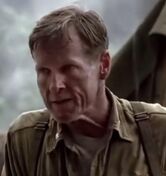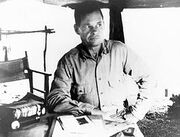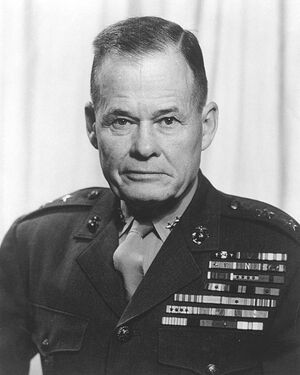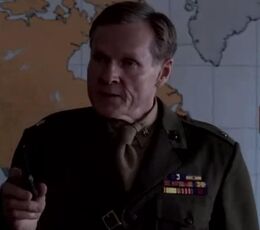LtCol. Lewis "Chesty" Puller was a highly decorated marine in the Marine Corps as well as the commander of the 1st Battalion, 7th Marines of the 1st Marine Division.
History[]
Puller was born in West Point, Virginia to Matthew and Martha Puller. His father was a grocer who died when Lewis was 10 years old, leaving him the head of the house. Puller grew up listening to old veterans' tales of the Civil War and idolizing Thomas "Stonewall" Jackson. He wanted to enlist in the army to fight in Mexico in 1916, but he was too young and could not get parental consent from his mother.
The following year, Puller attended the Virginia Military Institute but left at the end of his first year as World War I was still ongoing, saying that he wanted to "go where the guns are". Inspired by the 5th Marines at Belleau Wood, he enlisted in the United States Marine Corps as a private and attended boot camp at Parris Island, South Carolina.
Although he never saw action in that war, the Corps was expanding, and soon after graduating he attended NCO school and Officer Training School at Quantico, Virginia following that. Upon graduation from OTC on June 16, 1919, Puller was appointed to the pay grade of second lieutenant in the reserves, but reduction in force following the war led to his being put on inactive status 10 days later and given the rank of corporal.
Interwar Years[]
As a corporal, Puller received orders to serve in the Gendarmerie d'Haiti as a lieutenant, seeing action in Haiti. While the United States was working under a treaty with Haiti, he participated in over forty engagements during the ensuing five years against the Caco rebels and attempted to regain his commission as an officer twice. In 1922, he served as an adjutant to General Alexander Vandegrift, a future Commandant of the Marine Corps.
On March 6, 1924, Puller returned stateside and was finally recommissioned as a second lieutenant (service number 03158), afterward completing assignments at the Marine Barracks in Norfolk, Virginia, The Basic School in Quantico, Virginia, and with the 10th Marine Artillery Regiment in Quantico, Virginia. He was assigned to the Marine Barracks at Pearl Harbor, Hawaii in July 1926 and in San Diego, California in 1928.
In December 1928, Puller was assigned to the Nicaraguan National Guard detachment, where he earned his first Navy Cross for his actions from February 16 to August 19, 1930 when he led "five successive engagements against superior numbers of armed bandit forces". He returned stateside in July 1931 and completed the year-long Company Officers Course at Fort Benning, Georgia, thereafter returning to Nicaragua from September 20 to October 1, 1932 to earn a second Navy Cross.
After his service in Nicaragua, Puller was assigned to the Marine detachment at the American Legation in Beijing, China commanding a unit of China Marines. He then went on to serve aboard USS Augusta (CA-31), a cruiser in the Asiatic Fleet, which was commanded by then-Captain Chester W. Nimitz. Puller returned to the States in June 1936 as an instructor at the Basic School in Philadelphia.
In May 1939, he returned to the Augusta as commander of the onboard Marine detachment, and then back to China, disembarking in Shanghai in May 1940 to serve as the executive officer of 2nd Battalion, 4th Marines. He later served as its commanding officer.
World War II[]
Major Puller returned to the U.S. on August 28, 1941. After a short leave, he was given command of 1st Battalion, 7th Marines (known as 1/7) of the 1st Marine Division, stationed at New River, North Carolina, the new Marine amphibious base which would soon be renamed for the 13th Commandant of the Marine Corps, John A. Lejeune, MCB Camp Lejeune, North Carolina.
Puller's Speech[]
Puller's first appearence in the series is when he gives a motivational speech to some Non-Commisioned Officers, including Sgt. John Basilone and his friends.
Guadalcanal[]

Chesty Puller in Guadalcanal
Puller's first appearence in Guadalcanal saw him greeting the 1st Marines with the 7th Marines. Pfc. Conley asked him, "Colonel Puller, where ya headin'?""Tokyo! Care to join us?" joked Puller. The Marine jokingly declined and the 7th Marines passed the regiment. Puller is later seen reading a translated Japanese letter to the Marines which had some writing that entertained all of them. Puller then gives the news, the army has landed, much to the displeasure of the other Marines. Puller is later seen after a bombing on the Marines' barracks where he briefs the Marines and gives them a pep talk before assigning Basilone's friend, Sgt. Manuel "Manny" Rodriguez as a runner and johnny-on-the-spot. Eventually in the Battle for Henderson Field, Puller gets a message from Sgt. Briggs saying that the Japanese forces were coming his way. Puller sends Manny out to warn the others and he spends the rest of the battle giving out commands.

The real Puller on Guadalcanal
Puller was wounded by sniper fire twice off-screen. He survives and is awarded a third Navy Cross as well as a Purple Heart. Puller announces to Basilone later that he earned the Medal of Honor
Melbourne[]
Puller awards Basilone the medal, then tells Basilone that he will go home to participate in a War Bonds tour, to which the latter protests at first. Basilone eventually agrees to this and he leaves.
Cape Gloucester[]
Following this action, Puller was made executive officer of the 7th Marine Regiment. While serving in this capacity at Cape Gloucester, Puller earned his fourth Navy Cross for overall performance of duty between December 26, 1943 and January 19, 1944. During this time, when the battalion commanders of 3rd Battalion, 7th Marines and, later, 3rd Battalion, 5th Marines, while under heavy machine gun and mortar fire, he expertly reorganized the battalion and led the successful attack against heavily-fortified Japanese defensive positions. He was promoted to Colonel effective February 1, 1944 and by the end of the month, had been named commander of the 1st Marine Regiment.
Peleliu[]
Colonel Puller would lead the 1st Marines into the protracted battle on Peleliu, one of the bloodiest battles in Marine Corps history during September and October 1944, action where he earned his first Legion of Merit. The First Marines suffered 1,749 casualties from 12 September until relieved on 30 September by order of General Geiger. No Marine Regiment has ever suffered as many casualties in a single campaign.
His last appearence in the series would see him walking away from the Bloody Nose Ridge with the decimated 1st Marines being watched by Eugene Sledge's unit.
During the summer of 1944, Puller's younger brother, Samuel D. Puller, the Executive Officer of the 4th Marine Regiment, was killed by a sniper on Guam. Puller returned to the United States in November 1944, was named executive officer of the Infantry Training Regiment at Camp Lejeune and, two weeks later, Commanding Officer. After the war, he was made Director of the 8th Reserve District at New Orleans, Louisiana, and later commanded the Marine Barracks at Pearl Harbor.
Korean War[]
At the outbreak of the Korean conflict, Puller was once again assigned as commander of the 1st Marine Regiment, with which he made a landing at Inchon on September 15, 1950, earning his Silver Star. For leadership from September 15 to November 2, he was awarded his second Legion of Merit. He was awarded the Distinguished Service Cross from the Army for action from November 29 to December 5 of that same year, and his fifth Navy Cross for action during December 5–10 at the Battle of Chosin Reservoir. It was during that battle when he made the famous quote, "We've been looking for the enemy for some time now. We've finally found him. We're surrounded. That simplifies things."[5]
In January 1951, Puller was promoted to brigadier general and was assigned duty as assistant division commander (ADC) of the 1st Marine Division. On February 24, however, his immediate superior, Major General O. P. Smith, was hastily transferred to command X Corps when its army commander, Major General Bryant Moore, died. Smith’s temporary transfer left Puller in command of his beloved 1st Marine Division. Puller would serve as ADC until he completed his tour of duty and returned to the United States on May 20, 1951.

Puller at Korea
General Puller subsequently received promotions to major general and lieutenant general, and served in various command capacities until his retirement due to health reasons on November 1, 1955.
Later Life[]
Marines often adamantly allege that Chesty Puller was never awarded the Medal of Honor due to pressure from senior Army officers and even President Dwight D. Eisenhower. Marines still claim that senior Army officers hated Puller out of inter-service rivalry and jealousy, as well as from vocal and disparaging comments Puller often made about some Army units that he felt did not fight admirably during the escape from the Chosin Reservoir in the Korean War. Perhaps this obsession with Army officers persecuting Puller comes from the annihilation of the First Marines at Peleliu under Colonel Puller's command, and their replacement by Army troops of the 321st Infantry, 81st Division. Puller, still a Colonel in Korea had not received a promotion since Peleliu.
Earlier in the war, Puller was reported to have ordered Marines to gather all Army equipment abandoned by withdrawing soldiers and put it to good use. He later reportedly told an Army colonel who demanded the return of the equipment, "It all has USMC markings on it now and if you want it back, kick my ass." The equipment remained in possession of the Marines.
Adding to a conspiracy theory is the fact that when Puller passed out in the heat while inspecting a formation of Marines in 1955, he was ordered to Walter Reed Army Hospital for cardiac testing by the Defense Department, instead of Bethesda Naval Hospital. Bethesda is a Navy facility, staffed largely by Navy doctors, nurses, and medical personnel, and it has historically treated primarily naval personnel (Marines, sailors, and Coast Guard personnel). The official reason stated by the Defense Department for sending Puller to Walter Reed was that Walter Reed had a better cardiac diagnostic lab. The cardiac lab was greatly expanded during the presidency of Dwight Eisenhower, who as President and retired Army five-star general, preferred to be treated at an Army medical facility. Puller felt it was in fact a pretext to implement a conspiracy to remove him, insisting he had simply been overcome by the heat.
Following a series of cardiac tests at Walter Reed, Puller was found by Army cardiologists to have a weakened heart. He was then ordered into involuntary medical retirement, thus preventing him from becoming a possible future candidate for Commandant of the Marine Corps. He was denied appeals through Navy medical channels to get a medical waiver to allow him to remain on active duty. He was embittered by that chapter in his life, feeling the Army had cut him off at the knees and "stacked the deck" against him.
Puller and his wife, Virginia McCandlish Puller, retired to a quiet life in rural Virginia. He would always welcome all passing or visiting Marines in his home and would gladly talk to them about the Marine Corps. A visit to Chesty Puller at his home was considered a pilgrimage by many Marines, young and old alike, especially those who served under his command.
In 1965, Puller requested he be reinstated into the Marine Corps in order to see action in the Vietnam War, but the request was denied on the basis of his age.
Death[]
Puller died in Saluda, Virginia at the age of 73 and was buried in Christchurch Parish Cemetery on the southeast side of Christchurch School off Highway 33 (also called "General Puller Highway") in Christchurch, Virginia. General Puller's widow, Virginia, died in 2006 at the age of 97 and was buried next to him.
| This page uses Creative Commons Licensed content from [[Wikipedia:Chesty Puller | Wikipedia]] (view authors). |
Trivia[]
- Chesty Puller is one of the oldest marines featured in the series.
- All of his Non-WWII related sections, as well as some parts of of the WWII sections, were taken from his Wikipedia article.
- After the war, he was the first to pass away.
- William Sadler also has resemblance to his character.
- See Peleliu: A Second-Generation Perspective by Matthew Stevenson.
- Last Man Standing: The First Marine Regiment at Peleliu by Dick Camp.
- Puller and Staff Sergeant Elmo "Gunny" Haney both served with the Marines in World War I, and they were both born the same year. They also both fought on Guadalcanal, Cape Gloucester and on Peleliu.
- He's the only Marine in the series to reach the rank of Colonel.
See Also[]

Lieutenant General Lewis "Chesty" Puller
